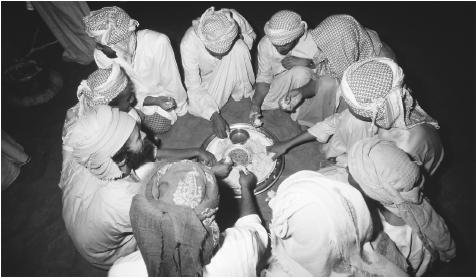Marriage, Family, and Kinship
Marriage:
Marriages are normally arranged. The preferred marriage is to a cousin. First choice is to a patrilateral cousin, and second choice is to a matrilateral cousin. Even the well-educated elite of the country, university medical students, express a preference for their families to arrange marriages for them. Love matches are very infrequent, as marriage is viewed more as a contract between two families with the major aim being to produce offspring for the next generation. In polygamous households (more common among the wealthy, but not restricted to them), the first wife tends to be a close cousin and the second wife a younger, less-close relative. In the past, men tended to take on additional wives—Islam permits up to four—but in recent years, men have tended to divorce first wives and remarry, often leaving divorced women destitute and reliant on the government for support.
Domestic Unit:
The domestic unit is generally an extended three-generation nuclear family; residence is usually patrilocal, with the husband's family. Although many nuclear family units reside in single residences, individual family members keep in constant contact with each other through either daily visits or regular telephone calls. It is not unusual to find families of eight, nine or ten persons living in one household. The eldest male has the greatest authority in the family while an elderly female usually takes responsibility for allocating tasks within the household.
Inheritance:
The rules of inheritance are entirely governed by the Shari'ah (Islamic law), which lays down the percentage of an estate that each relative may inherit. In descending order of shares, this moves from the direct descendants (sons, wives,

A group of Bedouin eat a meal. Omani cuisine revolves around rice.
Kin Groups. Omani culture is organized around the kin group as a large extended family or tribe inhabiting a particular valley or set of hamlets. There are also dispersed kin groups, the pastoral tribes, who move around with their livestock in search of grazing land in a territory normally regarded as theirs to use. Life revolves around the kin group in the interior of the country, while in the urban centers the extended family or tribe is the hub and locus of much activity and networking.
Socialization
Infant Care:
Omanis do not separate the infant or child from family rhythm or routine. The newborn child remains exclusively with her or his mother for the first forty days after birth. After that the infant sleeps, eats, and plays at her side, and is nursed on demand for two years. Infants are not offered particular stimulation, but soothed and calmed and encouraged to watch rather than interact.
Child Rearing and Education:
After the age of two, Omani children are encouraged to behave like miniature adults, taking on duties or hospitality toward guests at a very young age. They are only reprimanded, ever mildly, occasionally with a tap across the back of the legs. They are socialized to look to their peer group. Punishment for unusual or unacceptable behavior is often offered as: "What would your friends say?" Girls are circumcised with little ceremony at or just after birth and boys are circumcised in later childhood with some celebration of their entering an age of "reason."
Primary education for both boys and girls is encouraged. In the later intermediary and high school years, however, attendance by girls, particularly in rural areas, declines, largely due to a persistent pattern of early marriage. Many boys also leave school before the end of their secondary education in order to seek jobs, thus contributing to a large low-skill sector of the workforce. The government also operates a number of vocational training institutes.
Higher Education:
. In 1986, Oman opened its first university. Built upon a combination of American and English models of higher education, the first colleges were of medicine, engineering, science, Islamic studies and education, and agriculture. In the 1990s, several more colleges were opened including a faculty of commerce and economics and a faculty of Shari'ah and law. Enrollment in the university is nearly equally split between male and female students. It was only in 1993 that, under pressure from elements in the private sector and the government, the university administration decided to deny women admission to two colleges, engineering and agriculture. In the late 1990s, the government sanctioned several private colleges that emphasized business curricula.




Comments
Post a Comment